Heron's
Formula: Key Facts.Geometry Help.
|
Before beginning the proof of Heron's
Formula, we need to be aware of the following preliminary
propositions:
|
|
DEFINITION 1. Angle Bisector is a ray that
divides the angle into two congruent adjacent angles.
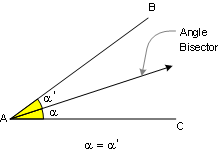
|
|
PROPOSITION 2. Triangle Congruence A.S.A. If two
angles and the included side of one triangle are congruent to
the corresponding parts of another, then the triangles are
congruent.

|
|
PROPOSITION 3. Any point on the bisector of
an angle is equidistant from the sides of the angle.
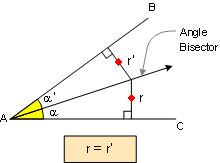
Proof: Apply Definition
#1 and
Proposition #2. |
|
PROPOSITION 4. If a line is
tangent to a circle, it is perpendicular to a radius at the
point of tangency.
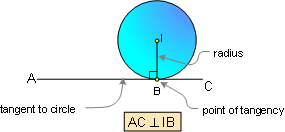 |
|
PROPOSITION 5. The bisectors
AA', BB' and CC' of the angles of a triangle ABC meet in a
point I, which is equidistant from the sides of the
triangle.
The incircle is the inscribed
circle of a triangle. The center of the incircle is called
the incenter, and the radius of the circle is called the
inradius.
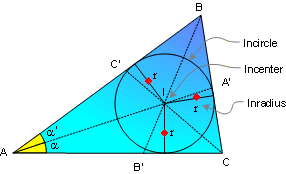
Proof: Apply Proposition
#3 and
#4.
|
|
PROPOSITION 6. An excircle of the
triangle is a circle lying outside the triangle, tangent to
one of its sides and tangent to the extensions of the other
two.
The center of an excircle is the
intersection of the internal bisector of one angle and the
external bisectors of the other two.
The center of an excircle is called
the excenter, and the radius of the circle is called the
exradius.
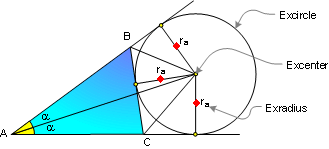
Proof: Apply Proposition
#3 and
#4.
|
|
PROPOSITION 7. Two tangent segments to a circle from an
external point are congruent.

Proof: Apply Proposition
#2,
#3.
|
|
PROPOSITION 8. Semiperimeter and Incircle.
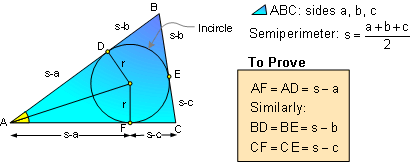
Proof: Apply Proposition
# 7.
|
|
PROPOSITION 9. Semiperimeter and Excircle.
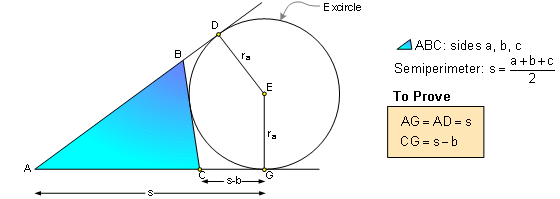
Proof: Apply Proposition
# 7.
|
|
PROPOSITION 10. Area of any triangle.
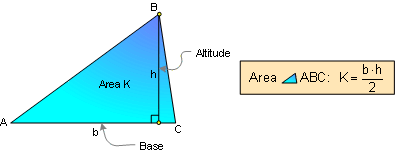
|
|
PROPOSITION 11. Area of any triangle.

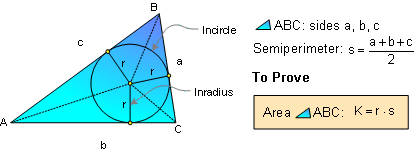
Proof: Apply Proposition
#10 and
#4.
|
|
PROPOSITION 12. Area of any triangle.


Proof: Apply Proposition
#10 and
#4.
|
|
PROPOSITION 13. Bisectors (CD and CE) of
supplementary angles (FCB and BCG) are mutually
perpendicular lines.

|
|
PROPOSITION 14. Two acute angles
are congruent if their sides are respectively perpendicular
to each other.
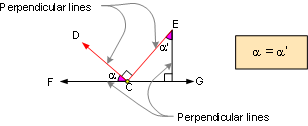 |
|
PROPOSITION 15. Triangle Similarity AA. If two
angles of one triangle are congruent to two angles of another
triangle, the two triangles are similar.

|
|
Home |
Geometry |
Search |
Problems |
Heron's Formula | Previous,
Next |
Email By Antonio Gutierrez
Last updated: April 19, 2008 |